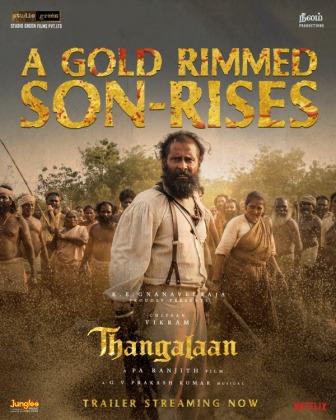Sivaramakrishnan S
In the annals of Indian cinema, few films have dared to challenge the dominant narratives of caste and colonialism as boldly as Pa. Ranjith’s upcoming magnum opus, “Thangalaan.” Set against the backdrop of the Kolar Gold Fields (KGF), this film promises to be more than just a cinematic experience; it’s a potential watershed moment in the representation of Dalit history and identity on the silver screen.
For centuries, the stories of Dalits have been silenced, distorted, or erased from mainstream narratives. The rise of Hindutva ideology in recent years has only exacerbated this erasure, pushing a monolithic view of Indian history that often ignores or misrepresents the experiences of marginalized communities. It is in this context that “Thangalaan” emerges as a powerful counter-narrative, one that has the potential to reshape public discourse on caste, colonialism, and identity.
The film’s setting in KGF is particularly significant. During the British colonial period, KGF saw a large-scale migration of Dalits from Tamil Nadu, who found employment and, to some extent, freedom from the oppressive caste structures of their home villages. This historical backdrop allows Ranjith to explore a nuanced relationship between Dalits and British colonizers – a relationship far more complex than the simplistic anti-colonial narrative pushed by Hindutva forces.
Indeed, the history of Dalit-British relations is a testament to the complexities of colonial rule in India. While it’s undeniable that British colonialism had devastating effects on India as a whole, it also, paradoxically, provided opportunities for social mobility to some of India’s most oppressed groups. The introduction of the Indian Penal Code, replacing the caste-based Manusmriti, and the opening up of education and employment opportunities, albeit limited, marked a significant shift for Dalit communities.
One of the most potent symbols of this complex relationship is the Battle of Bhima Koregaon in 1818. In this historic encounter, Dalit Mahar soldiers, fighting for the British East India Company, defeated the upper-caste Peshwa army. This victory is celebrated annually by millions of Dalits as a moment of pride and resistance against caste oppression. The trailer and war song of “Thangalaan” seem to evoke imagery reminiscent of this battle, suggesting that Ranjith might be drawing parallels between these historical events and the narrative of his film.
By bringing these narratives to the forefront, “Thangalaan” is not just telling a story; it’s reclaiming history. It’s challenging the dominant narratives that have long relegated Dalits to the margins of society and history. This is why the success of this film is crucial – it’s not merely about box office numbers or critical acclaim, but about the validation and mainstreaming of Dalit perspectives and experiences.
The potential impact of “Thangalaan” extends far beyond the realm of cinema. In a country where caste discrimination remains a harsh reality despite constitutional prohibitions, films like these play a crucial role in shaping public opinion and fostering dialogue. They provide a counter to the rising tide of Hindutva ideology, which often seeks to gloss over caste inequalities in its vision of a homogenous Hindu society.
Moreover, “Thangalaan” continues Ranjith’s mission of creating an ecosystem for Dalit art and expression. From his earlier works like “Kabali” and “Kaala” to his efforts in promoting Dalit musicians and artists, Ranjith has been at the forefront of a cultural revolution. The success of “Thangalaan” would further solidify this movement, potentially opening doors for more Dalit filmmakers and artists to tell their stories.
However, the road ahead is not without challenges. There are whispers of powerful forces working against the film’s success, given Ranjith’s outspoken criticism of both state and national governments. The film’s portrayal of British colonizers in a nuanced light might also face backlash from nationalist quarters. Yet, it is precisely these challenges that make “Thangalaan” a significant cultural and political event.
As we approach the film’s release on August 15th, it’s crucial to recognize what’s at stake. “Thangalaan” is not just a film; it’s a continuation of a 2,500-year-old struggle for equality and dignity. Its success or failure will have repercussions far beyond the world of cinema, potentially influencing the course of social and political discourse in India.
For those of us committed to the cause of social justice and equality, supporting “Thangalaan” becomes more than a choice – it becomes a responsibility. By watching, discussing, and engaging with the film, we participate in a larger movement of reclaiming our history and asserting our identity.
In the end, “Thangalaan” reminds us of the power of art to challenge, inspire, and transform. It stands as a testament to the resilience of Dalit communities and their ongoing struggle for representation and dignity. As we eagerly await its release, let us prepare to engage with it not just as viewers, but as participants in a historic moment of cultural resistance and reclamation.
Jai Bhim!
~~~
Sivaramakrishnan S, has a background in banking; his days are spent analyzing numbers, but his evenings are dedicated to exploring the complexities of society through writing. He is particularly interested in the intersection of caste, cinema, and social change in India.










